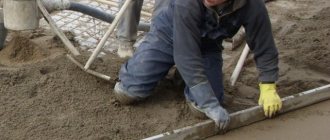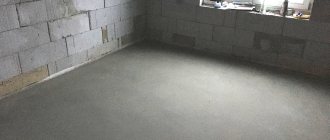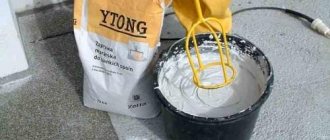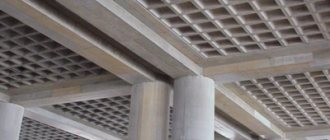Sand concrete of the popular M300 brand differs from classical concrete in the absence of gravel filler, having as the latter only fine- and coarse-grained sand, which provides a paste-like consistency of the finished composition. Due to its high plasticity, as well as taking into account the introduction of special modifiers into the dry mixture, this auxiliary building material is well leveled, easily fills cavities and seams, quickly hardens after laying and retains its original strength for a long time.
Material composition
Before considering the question of why sand concrete is needed, it is advisable to familiarize yourself with its composition. It is important to note that regardless of the manufacturer, the components and proportions differ slightly. As a rule, the following recipe is maintained:
- fine river sand (maximum 3 mm). Large fraction more than 3 mm;
- Portland cement M400, 500;
- sometimes the composition contains granite chips;
- modifiers or plasticizers.
A plasticizer is added to PB in order to increase resistance to frost and sudden temperature changes, increase the strength of the material and moisture resistance. In addition, chemical additives help sand concrete harden faster.
Characteristics of dry mixtures
Ensuring the mechanical and physical qualities of a building material—freezing/thawing cycles, consistency, plasticity, mobility, strength, density—depend on proper calculation of the components in the composition. The more correct the proportions and the better the quality of the additives, the more tolerant the concrete is to mechanical loads. The recipes of the listed brands are precisely verified, which distinguishes them favorably from homemade formulations.
The M150 mixture consists of sand, Portland cement, mineral powder, plasticizers and additives. It is used for plastering and masonry of unloaded or moderately loaded building structures. The mixture has an optimal ratio of cost and quality. This building material is widely used for primary plastering work - leveling walls and ceilings.
Sand concrete M300 is in demand in all types of construction work for the climatic conditions of the south, middle zone and north of Russia. In liquid form, it is designed for significant loads, for example, pouring foundations, floors, and is also suitable for leveling and arranging rough floor screeds. The resulting structures are durable, do not shrink, are moisture-resistant, environmentally friendly, and have a long service life. Examples of relationships between quality and brand:
- Sand concrete Baumax. The viability of the solution is 45 minutes, the compressive strength after 28 days is 300 kg/m2, the adhesion strength to concrete is 0.8 MPa;
- Dauer sand concrete. Pot life 45 min, compressive strength 300 kg/m2, adhesion 0.8 MPa;
- Sand concrete Stone flower M300 (50 kg). Viability 120 min, compressive strength 30.0 MPa, adhesion strength - 0.3 MPa.
Laying coatings (laminate, linoleum, tiles) is possible after 5 days. Frost resistance of the building material is about 50 cycles. The temperature of the base on which the layer is applied and the air is + 5 - +30 degrees, hardening time is 2-3 days. Considering all these conditions, you can begin construction.
Technical features
Among the technical features of the material, it is customary to highlight the following aspects:
- To prepare the solution, 1 kg of dry mixture requires 0.15 liters of water without impurities.
- If you need to make a floor screed up to 10 mm thick, 20 kg of mixture will be required per 1 m².
- The approximate preparation time for the mixture is 2 hours.
- Waterproof up to 99%.
- The screed sets within 3 hours.
- You can move on the floor only after 5 days from the moment of pouring.
- Within a month after pouring, the material begins to achieve the highest technical characteristics.
Attention!
It is recommended to familiarize yourself with the standards specified in GOST. They are presented in the table below.
Method of calculating flow
Brands and use of sand concrete
To purchase a sufficient amount of material, you need to know the consumption of M300 sand concrete. On average, these figures are about 20 kg of dry component per square meter. The layer thickness will be 10 mm. If you have to work with floor slabs, the thickness of the layer increases. It needs to be made no thinner than 20 mm.
To clarify the consumption indicators, it is necessary to calculate the average layer thickness. This is done by shooting the base, for which it is worth using a laser builder. Several measurements are taken at different points and the absolute deviation is determined. It is multiplied by two, the resulting number is the average thickness. It is permissible to set several levels of heights, add up their indicators and divide by the number of measurements.
For example, if you need to fill a room of 60 square meters. m by 6 cm, then each meter will require 20 kg of material. Taking into account the thickness, it turns out to be 120 kg, and 7200 kg of mixture is needed for the entire area, which is 150 bags. When making calculations, it is important to take into account the base material. The thickness of porcelain tiles is usually 8 mm, and the adhesive mortar is 12 mm.
Video on the topic: Proportions of M300 concrete
Publications on the topic
Proportions for preparing cement mortar
Rent a concrete pump in Krasnodar
Self-production of polystyrene concrete
Sand concrete - GOST
According to the classification of the state standard, sand concrete belongs to fine-grained concrete, and according to its intended purpose, to structural concrete and has the characteristics indicated in the tabular data.
| Index | Standard according to GOST |
| Color | Grey |
| Fraction (particle size) | 0.10-3.00 mm |
| Water consumption, l/kg | 0,20-0,25 |
| Strength grade | M100-M500 |
| Consumption | From 1.9 kg/m² with a layer of 1.00 mm |
| Viability | At least 120 min |
| Setting period | 180 min |
| Ready to lay the coating | After 5 days |
| Possibility of movement | After 48 hours |
| Compressive strength after 28 days | 30.00 MPa |
| Full maturity | 28 days |
Areas of application of sand concrete M300
Due to its low price and ease of dilution, sand concrete M300 belongs to the most popular modern building materials and is widely used in the process of preparing masonry mixtures for bricks and reinforced concrete products, when pouring reinforced belts and foundations, erecting monolithic structures and arranging stairs, during repair work and landscaping of local areas.
In addition to its main purpose, M300 grade sand concrete can be used as a base or an additional component of more complex building mixtures: cement insulation mortars, expanded clay concrete, reinforced concrete, etc.
Technical features by PB brands
The following table shows the characteristics of PB brands:
| Brand | Strength, kg/cm² | Application | Features of the composition |
| M50, M100 | 50, 100 | Sealing seams and cracks. | Minimal amount of cement, no lime. |
| M150 | 150 | Masonry and plaster mortar. | Presence of modified additives. |
| M200 | 200 | Screed for heated floors | The filler is a large fraction of quartz sand. |
| M300 | 300 | Pouring formwork for reinforced concrete structures and foundations. Screeding floors of industrial premises. | Adding plasticizers to increase strength. |
| M400, M500 | 400, 500 | Construction of monolithic reinforced concrete structures in multi-storey buildings. | High Portland cement content. |
Choosing a sand concrete manufacturer for floor screed
Having decided on all the parameters, you need to make the last, and perhaps the most difficult, choice. You need to decide which company to buy sand concrete from. There may be a dozen or more manufacturers in large specialized stores. It's easy to get confused.
There's really not much difference. It is important not to fall for a fake that was mixed up in the garage. This usually affects brands with a well-advertised name. If you know what the original packaging should look like, or the seller is trusted, you can use well-known brands. But regional factories are safer in terms of counterfeiting. Their quality is no worse, and there are very few fakes.
How to choose a manufacturer... Based on reviews and experience in using other mixtures
Another selection criterion is “heredity.” If you plan to pour a leveling screed over a regular screed, it is better if they are from the same manufacturer. In this case, there will be no questions about product compatibility. Then it’s better to buy everything at once - both leveling mixtures and sand concrete for floor screed.
Where is sand concrete used?
What sand concrete is used for directly depends on the marking of the building material:
- markings M50, M100
are used in restoration work to replace old coatings and shallow cracks. It is strongly recommended to purchase dry mixture in bags of at least 25 kg; - M150
is often used to prepare mortar for masonry. Comparing the universal cement mixture, the interblock joint made of PB has increased strength and moisture resistance up to 100%; - to make a screed for a heated floor, it is recommended to purchase M200
. The material effectively retains heat for a long period of time; - marking M300
is a universal PB that is used for the use of reinforced concrete structures. This is a mandatory element, without which it is impossible to cast new wall panels that are used as load-bearing or interior structures; - M400, M500
are especially popular in construction, since sand concrete of this marking can withstand high loads. Particularly relevant in the construction of multi-storey structures.
Scope of use
The material is universal and therefore widely used in construction. It is actively used during the construction of concrete structures, including residential, household, utility premises and large complexes. Using sand concrete M300, floors are screeded and foundations are poured. Other applications:
Sand concrete mixture M-300
- Leveling vertical and horizontal surfaces.
- Sealing seams.
- Restoration work.
- Laying paving slabs.
- Foundation work.
- Brickwork.
- Filling the blind area.
- Laying staircases and garden paths.
- Emergency work requiring rapid hardening of the material.
Sometimes a similar mixture is used to prepare expanded clay concrete. In this case, it acts as the main solution. Despite the wide range of applications, the main purpose of M300 remains the creation of a wear-resistant, high-strength floor screed. In the future, it will not require the manufacture of additional coating.
How building material is stored and packaged
In order for the use of sand concrete to be as effective as possible, it is important to follow the storage and packaging rules in production. Delivery to stores and hypermarkets must be carried out exclusively in highly sealed paper bags. Standard packaging includes weights of 25, 40 and 50 kg. As a rule, the marking, weight, and expiration date of the product are always indicated on the outside of the package.
Sometimes the manufacturer places information on the packaging about why sand concrete is needed and for what purposes it can be used, and how long it normally takes to harden. Each batch must have a certificate confirming its quality.
As for storage rules, it is best to keep the mixture in rooms with a good ventilation system and low humidity. The optimal temperature range is +5…+30°C.
Areas of use
Some nuances of the cost of sand concrete M300
| Brand of mixture | Bag weight, kg | Price for 1 bag, rubles | Price per ton, rubles |
| Stone flower M300 | 40 | 120 | 3000 |
| 50 | 145 | 2900 | |
| Sand concrete Rusean M300 | 40 | 145 | 3620 |
| LUIX M300 Roussean | 40 | 130 | 3250 |
| Standard M300 | 40 | 110 | 2750 |
The prices given are relevant for the central regions of the country and do not include the cost of delivery, which in an unfavorable situation can increase costs by 25 - 50%.
What technology is used for cooking
To prepare a high-quality solution, you do not need to have professional education or special knowledge.
- First you need to mix the dry mixture with warm water (the temperature should not be higher than 20 degrees). The container is selected depending on the required volume (it is recommended to take a trough or use a concrete mixer). Water is introduced into the composition gradually in small portions.
- The solution must be mixed until a homogeneous consistency is obtained. If the manufacturer does not indicate the ratio of the mixture to water on the packaging, then you can use the universal formula: 10 kg requires 1.5 liters of water.
- It is important to ensure that there are no dry lumps of the mixture or detachment in the solution. Next, the mixture should stand for 10 minutes so that it begins to harden.
- Next, the resulting consistency must be mixed again and prepared for further use. The batch is carried out within 2 hours.
After all the steps in the instructions have been completed, the concrete begins to harden and acquire the proper technical properties for further use.
Sand concrete is actively used in modern construction because it does not shrink much in comparison with other building materials. In addition, it does not react to direct exposure to rays and does not absorb excess moisture. But experts strongly do not recommend using the mixture for plastering.
This is a material that is universal in its application. However, it is important to note that it costs slightly more than classic concrete. But most of the advantages more than cover this nuance.
Author of the article
Choosing a brand of sand concrete for floor screed
Depending on the composition of the mixture, sand concrete is produced in different grades (that is, different strengths). The minimum strength is M100, the maximum is M500. What type of sand concrete is needed for floor screed depends on how the floor will be used.
- M100 and M150 for screeds in most cases have insufficient strength; they are used more often for plastering walls. This mixture can be used to make flooring in utility rooms or in the country house. Its strength is more than enough to move people and animals, but not for transport. In a house, such a screed can be done if linoleum or carpet is simply laid and there is no heating.
- According to the recommendations of manufacturers, for laminate, vinyl tiles (art vinyl), parquet, parquet boards, ceramic tiles, porcelain stoneware, the base should have a strength of M200 or M250. Therefore, under these types of coatings, a screed of sand concrete of the appropriate brand is made.
The grade of sand concrete for floor screed is determined by the type of floor covering and how the floor will be used - Pouring screed over a heated floor (water or electric) is recommended by a brand no lower than M250. M300 is also possible. For normal heat transfer there must be sufficient density, which is what characterizes concrete of higher grades. The second point is that there must be a sufficiently strong ceiling over the flexible water heating pipes to prevent sagging and sagging under load.
- M300 - this strength can be used if a high load is provided. For example, when laying blocks or panels of multi-story construction, when pouring the foundation of a private house. For a non-heated floor in a private home, such strength is excessive. Perhaps for a garage where heavy vehicles will move. Less durable concrete can also withstand passenger cars. Sand concrete M300 can also be used for external work - for formwork around the house, for example. It is also suitable for pouring a platform for a car and for constructing concrete paths. It is usually frost-resistant enough to last for a sufficient number of years.
High-quality mixtures are used to fill the foundations of multi-story buildings. In private construction, it is not advisable to use a grade higher than M300 - There is simply no place to use concrete higher than M300 in private construction. This level of strength will not be in demand. And since the price increases with the increase in brand, there is no need to spend extra money.
In general, parquet used to be laid on a screed with a strength of M75 or even M50. Why are the requirements higher today? Because previously they used bitumen mastic. Its strength is close to these types of concrete. Modern glue, on which parquet or parquet boards are glued, has much higher strength. In order for the coating to stick and not move away from the base, the strength of the adhesive and the base should not differ by more than 50 units. Since the glue generally has a strength of M200 or M250, the base is required to be the same. Therefore, under the parquet we use sand concrete for floor screed M200 or M250.
The same applies to the floor on which ceramic tiles or porcelain stoneware are laid. Tile adhesive also has high strength. Therefore, the screed under the tiles should be made of sand concrete of a fairly high grade - M200 and no lower.
Description and features of sand concrete
Sand concrete is otherwise called fine-grained concrete. In normal use, crushed stone with a diameter of up to 2 centimeters is allowed. Sand concrete is sieved through a mesh with 3-millimeter cells. At the same time, the flakiness of the grains is monitored. The concept is derived from the word “bream”. This fish is distinguished by a tall, but laterally compressed body. Flaky crushed stone is flat, like bream.
Ready-made sand concrete solution
Flaky crushed stone deprives the solution of its ability to compact well. Fine and voluminous filler granules allow the concrete to compact as much as possible. This is the key to moisture resistance. In order to freeze inside concrete, tearing it from the inside due to expansion, water needs to get into the material. If there are no pores, there are no risks. Therefore, sand concrete is ideal for street objects.
Because fine aggregate mortar compacts as much as possible, more cement is required than for conventional concrete. There's a price tag associated with this. Cement is the most expensive part of concrete. The role of fine crushed stone in sand concrete is played by the sand itself. Its large fraction is used. In ordinary concrete, on the contrary, the sand is fine.
Sedimentary rock may contain granules of different minerals. Silicate sand is ideal. Its base is quartz. This is a stone that contains oxygen and silicon. The latter gives the granules a special hardness. On the Mohs scale it is equal to 7 points. It is quartz sand that is added to sand concrete. As a rule, it is mined from the river bottom.
There is also no crushed clinker in sand concrete. The concept is German, translated as “brick”. That's what we're talking about, actually. But the gypsum component, characteristic of cement, is preserved. Sometimes granite chips are added. Plasticizers are also not always used.
Sand concrete grade 300
Sand concrete contains Portland cement. Many sources indicate the concept as something special. In fact, Portland cement is the most common and common. The mixture was invented in 1824 by Joseph Aspdin. The Englishman noticed the similarity of the mixture with Portland limestone. Hence the name of the new building material.
The components of Portland cement are minerals, which include oxides of calcium, aluminum, magnesium, silicon and iron. Carbon dioxide is released when heated in a cylindrical furnace. Portland cement is also found in ordinary concrete. It has subspecies. The grades are also typical for sand concrete.
How to make it yourself
Each builder can prepare a cement mixture with his own hands, for which the following materials will be needed:
- Portland cement M500 (the output will be sand concrete M300);
- sand;
- water.
The proportions for preparing the mixture are as follows: 1 bucket of sand requires 3.5 kg of cement and 2.3 liters of water (based on a water-cement ratio of 0.5).
Sand concrete mixture - material consumption
The consumption of the mixture depends on several initial data:
- required thickness of the finished layer;
- base parameters;
- quality characteristics of the finishing coating that should be obtained.
For example, when using sand concrete for a screed with a thickness of 1 cm and an area of 1 m², at least 20.00 kg of dry sand concrete M300 will be required.
When preparing the mixture in a concrete mixer, all components must be dry, then you will get high-quality sand concrete; how to dilute the material is discussed below.
Sequencing:
- sand is loaded first;
- then cement;
- when a large volume is required, it is advisable to first mix the dry components in parts and unload them into one container, then pour the entire volume of water into the concrete mixer and gradually load the entire cement-sand mixture. The finished material will be homogeneous, meeting the strength requirements of M300;
- the mixture is kneaded for several minutes and unloaded;
- Water is poured into the drum for cleaning.
Books on the topic:
Modern work on the construction of walls and partitions - Galina Serikova - 45 rubles - link to book review
Concrete with effective additives - Anatoly Zotkin - 841 rubles - link to the book review Building materials and products - Isaac Nanazashvili - 200 rubles - link to the book review
Reinforced concrete and stone structures. In 2 parts. Part 1. Reinforced concrete structures - Vladimir Evstifeev - 1,379 rubles - link to book review
Handbook of a modern designer - Gennady Verzhbovsky - 280 rubles - link to book review











